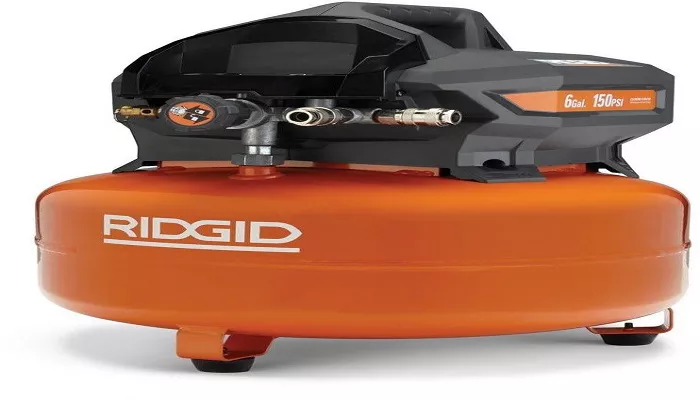The Ridgid Pancake Air Compressor is a popular choice among professionals and DIY enthusiasts due to its compact design, portability, and reliable performance. Whether you’re a contractor, carpenter, or hobbyist, understanding how to properly operate and maintain this tool ensures efficiency, safety, and longevity.
Key Features & Specifications
Before operating the Ridgid Pancake Air Compressor, it’s essential to understand its key features and technical specifications:
- Motor Type: Oil-free, maintenance-free pump
- Tank Capacity: Typically 4-6 gallons (pancake style)
- Max PSI (Pounds per Square Inch): 150 PSI (varies by model)
- CFM (Cubic Feet per Minute): ~2.6 CFM at 90 PSI (ideal for nail guns and small tools)
- Power Source: 120V electric (standard household outlet)
- Weight: 30 lbs (lightweight and portable)
- Noise Level: 78 dB (moderate noise, hearing protection recommended)
These specs make it ideal for framing, roofing, trim work, and light pneumatic tool use.
Safety Precautions
Air compressors can be dangerous if mishandled. Follow these critical safety measures:
Personal Safety Gear
- Hearing Protection: Compressors generate noise (≥78 dB). Wear earplugs or earmuffs.
- Eye Protection: Flying debris or hose whip can cause injury. Always wear safety glasses.
- Gloves & Proper Clothing: Avoid loose clothing that could get caught in moving parts.
Workspace Safety
- Ventilation: Operate in a well-ventilated area to prevent carbon monoxide buildup (if using gas models; electric models do not produce fumes).
- Stable Surface: Place the compressor on a flat, dry surface to prevent tipping.
- Clear Hose Path: Ensure the air hose is free from obstructions to avoid tripping or kinking.
Operational Safety
- Check Pressure Ratings: Never exceed the tool’s max PSI (check tool manual).
- Release Pressure Before Maintenance: Always drain the tank and disconnect power before servicing.
- Avoid Overheating: Allow the compressor to cool if it runs continuously for extended periods.
Step-by-Step Setup & Operation
Initial Setup
Unboxing & Inspection
- Remove the compressor from packaging.
- Check for shipping damage (dents, leaks, loose parts).
- Verify all accessories (hose, fittings, manual) are included.
Positioning the Compressor
- Place on a stable, level surface near a power source.
- Ensure the area is dry (water can damage electrical components).
Attaching the Air Hose
- Connect the air hose to the compressor’s quick-connect coupler.
- Secure with a wrench if threaded (avoid over-tightening).
- Attach the other end to your pneumatic tool (e.g., nail gun).
Powering On & Adjusting Pressure
Plugging In
- Use a grounded 120V outlet.
- Avoid extension cords (if necessary, use a heavy-duty 12-gauge cord).
Setting the PSI
- Locate the pressure regulator knob (usually near the hose connection).
- Turn the knob to adjust PSI based on tool requirements (e.g., 70-90 PSI for nail guns).
- Never exceed the tool’s max PSI (check tool manual).
Filling the Tank
- Turn the ON/OFF switch to “ON.”
- The motor will start, filling the tank until it reaches the cut-out pressure (e.g., 150 PSI).
- The compressor will shut off automatically when full.
Using Pneumatic Tools
Testing Airflow
- Pull the trigger on the tool to ensure consistent airflow.
- If air sputters, check hose connections or adjust PSI.
Operating the Tool
- Hold the tool firmly and engage as needed (e.g., drive nails with a framing gun).
- Monitor air pressure—if it drops significantly, pause to let the compressor recharge.
Shutting Down
- Turn the compressor OFF.
- Depress the tool trigger to release residual air.
- Drain moisture from the tank (see maintenance section).
Common Applications
The Ridgid Pancake Air Compressor is versatile for
- Framing & Roofing: Powering nail guns (16-gauge, 18-gauge, framing nails).
- Trim Work: Finish nailers for baseboards and crown molding.
- Inflating Tires & Sports Equipment: Use with an inflation gun.
- Light Spray Painting: Small HVLP spray guns (check CFM requirements).
- Blowing Dust & Debris: Use an air nozzle for cleaning workspaces.
Maintenance & Troubleshooting
Routine Maintenance
Draining Moisture
- After each use, open the tank drain valve (located at the bottom).
- Let all moisture escape to prevent rust and corrosion.
Checking for Leaks
- Apply soapy water to hose connections; bubbles indicate leaks.
- Tighten fittings or replace damaged hoses.
Inspecting the Air Filter
- Clean or replace the intake filter periodically (prevents dust buildup).
Lubricating Moving Parts (If Applicable)
- Most pancake compressors are oil-free, but check the manual for greasing points.
| Issue | Possible Cause | Solution |
|---|---|---|
| Compressor won’t start | No power, tripped breaker | Check outlet, reset breaker |
| Low airflow | Clogged filter, hose leak | Clean filter, fix leaks |
| Excessive noise | Loose parts, motor strain | Tighten bolts, allow cooling |
| Tank not filling | Faulty pressure switch | Replace switch or consult technician |
Conclusion
The Ridgid Pancake Air Compressor is a powerful, portable tool for various professional and DIY tasks. By following proper setup, operation, and maintenance procedures, you ensure optimal performance, safety, and durability.

